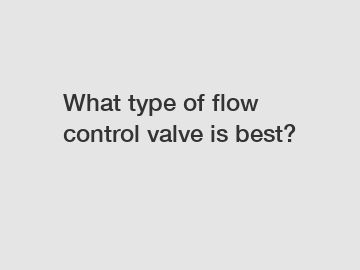What type of flow control valve is best?
What type of flow control valve is best? This question often arises when it comes to optimizing fluid flow in various industries. To determine the answer, we need to consider several factors including the application requirements, operational conditions, and system design. By thoroughly understanding these aspects, we can determine the most suitable type of flow control valve, discern its significance, and analyze its impact.
Upon analyzing the requirements of the application, we can evaluate different flow control valve options. One such type is the needle valve, which is known for its precision in regulating flow. The fine-threaded stem allows for precise adjustment, granting operators accurate control over the flow rate. Needle valves are commonly used in applications that require low flow rates or fine-tuning, such as laboratory equipment and gas chromatography. Its ability to provide exceptional control and resistance to fluid erosion makes it a suitable choice for these industries.
Another type of flow control valve to consider is the ball valve, which offers efficient and robust regulation of flow. This valve functions by rotating a ball with a hole through which the fluid passes. The flow rate can be controlled by adjusting the angle of the ball. Ball valves are widely used in water supply systems, oil and gas pipelines, and chemical industries due to their ability to handle high-pressure and high-temperature conditions effectively. Their durability, reliability, and easy operation contribute to their popularity in these applications.

Furthermore, the butterfly valve is worth mentioning as it offers a versatile solution for flow control. This valve consists of a disk-shaped closing mechanism, known as the butterfly, that rotates to regulate flow. Butterfly valves are suitable for large-scale applications due to their compact design, simple operation, and cost-effectiveness. They are widely utilized in HVAC systems, water treatment plants, and power generation industries. The ability of butterfly valves to handle large flow volumes and maintain low-pressure drops makes them a preferred choice in these areas.
Determining the best type of flow control valve involves carefully considering the specific requirements of the application and the characteristics of each valve type. Once the suitable valve type is chosen, its significance becomes apparent. An optimized flow control valve ensures efficient and precise regulation of fluid, leading to improved system performance, reduced energy consumption, and enhanced overall productivity. The right valve selection can also contribute to increased equipment lifespan and minimized maintenance costs.
The choice of flow control valve can have significant impacts on a system's operational efficiency and reliability. Incorrect valve selection can result in inadequate flow control, leading to system malfunctions, increased wear and tear, and potential safety hazards. By carefully considering factors such as flow conditions, pressure ratings, material compatibility, and cost-effectiveness, engineers and operators can make informed decisions to optimize flow control and maximize system performance.
In conclusion, determining the best type of flow control valve requires a thorough understanding of the application requirements, operational conditions, and system design. Needle valves are ideal for precise control and low flow rates, while ball valves excel in high-pressure and high-temperature environments. Butterfly valves offer versatility and cost-effectiveness for large-scale applications. The significance lies in optimizing fluid flow, improving system performance, and reducing maintenance costs. Choosing the right valve can have a profound impact on system efficiency, reliability, and safety.
Are you interested in learning more about Electromagnetic Ball Valve Price, wholesale Cartridge Check Valve Factory, wholesale one way hydraulic check valve? Contact us today to secure an expert consultation!

Comments